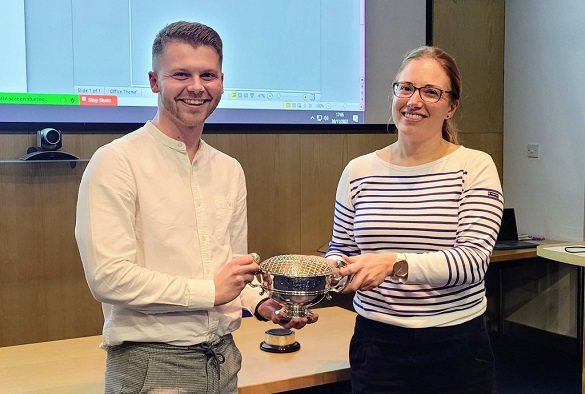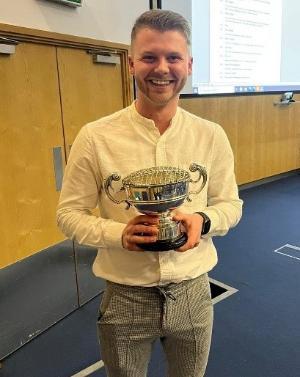Elliot Croft Wins the Roy Mapstone Prize for Developing Novel Long-Acting Microarray Patches at the 27th Ophthalmology and Vision Science Research Prize Meeting

Elliot Croft, a PhD student at the Centre of Excellence for Long-acting Therapeutics, working under the supervision of Dr Helen Cauldbeck was awarded the esteemed prize for best presentation by a trainee scientist at St. Pauls Eye Hospital at the 27th annual Ophthalmology and Vision Science Research Prize Meeting 2022.
The Roy Mapstone prize is awarded for outstanding work in Ophthalmology and Vision Science to an exceptional researcher showing excellence in research, presentation style and their ability to captivate their audience and convey their expertise in an understandable way.

Elliot was handed the trophy after impressing the judges with a presentation about his work on the development of dissolvable microneedle array patches (DMAPs) for the treatment of glaucoma. The judging panel consisted of Dr Victoria Kearns, Dr Jignasa Mehta and Professor Stephen Kaye, all from the University of Liverpool's Institute of Life Course and Medical Sciences. All judges unanimously ranked Elliot’s as the best presentation on the day, beating a range of talks from other impressive trainee scientists.
Elliot said “It’s a great honour to be awarded the Roy Mapstone award for 2022, especially considering the high quality of talks given by the other speakers. Special thanks goes out to the judges and Neeru Vallabh for organising this meet and giving me the opportunity to present”.
Glaucoma is the 2nd leading cause of irreversible blindness in the world. The primary drug delivery approach for glaucoma is the use of topical dosing of therapeutics. However, poor bioavailability of topical dosing introduces the need for repetitive regimens to sustain a therapeutic concentration, causing toxicity issues and poor patient adherence.
The use of microneedles combines both the user-friendly, pain-free nature of topical dosing and benefits from increased permeation through ocular tissue, linked to its needle-like shape, thus increasing the bioavailability and permeability of the active pharmaceutical ingredient for anterior drug delivery.
DMAPs are fabricated using polymers which are optimised for drug administration which can provide increase drug bioavailability of chosen therapeutics within ocular tissue. This can improve the standard of care for glaucoma patients as it removes the need to repetitive topical regimens, minimises the risk of challenging side effects and improves adherence and completion rates of therapy.
Elliot is a PhD student in the Cauldbeck group, working under the supervision of Dr Helen Cauldbeck who said “We have long believed that DMAPs offer an exciting alternative to existing glaucoma treatments. It’s brilliant to see Elliot’s hard work and high-quality research recognised by a panel of expert scientists and clinicians, and I’m personally very proud to see how Elliot has developed during his PhD studentship. I am grateful to the University of Liverpool Doctoral Network in Technologies for Healthy Ageing for funding this research and investing in Elliot’s career development.”
The Cauldbeck Group is a team of interdisciplinary scientists focused on the use of radiochemistry to provide deeper insights into the fields of nanomedicine, polymer chemistry, formulation and biomaterials science. Find out more about the work taking place by the Cauldbeck group in the Radiomaterials Lab here.
This award is the latest in a series of impressive achievements. Elliot recently won runner-up prizes for the Chemistry Symposium Days held in 2021 and 2022 as well as being awarded the best oral presentation for the 2021 Joint CDT/UKSB Future Leaders Conference. In September 2022, Elliot travelled to Bordeaux, France to attend the 32nd Annual Conference of the European Society for Biomaterials.